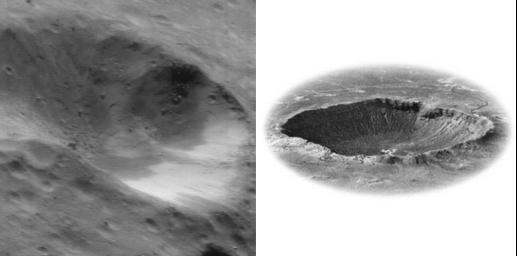
|
Common Craters (Earth and Eros)
- Click the image above for a larger view
- Full-Res JPEG (750 x 372) (27.2 kB)
- Full-Res TIFF (750 x 372) (181.8 kB)
Caption:
The late Dr. Eugene Shoemaker, who many consider the founder of modern planetary science, did pioneering work at Meteor Crater, Arizona, documenting the effects of impact cratering as a planetary process. When part of a comet or asteroid strikes a planet or another asteroid, the resulting shock wave and excavation of rock and soil leave a characteristic landform that looks much the same from planet to planet, asteroid to asteroid. To illustrate the point, this NEAR Shoemaker image of a crater on Eros (left), taken July 6, 2000, from an orbital altitude of 50 kilometers (31 miles), is displayed next to and at approximately the same scale as Meteor Crater.
Background Info:
Built and managed by The Johns Hopkins University Applied Physics Laboratory, Laurel, Maryland, NEAR was the first spacecraft launched in NASA's Discovery Program of low-cost, small-scale planetary missions. See the NEAR web page at http://near.jhuapl.edu/ for more details.
Cataloging Keywords:
| Name | Value | Additional Values |
|---|---|---|
| Target | 433 Eros | |
| System | Near Earth Objects | |
| Target Type | Asteroid | |
| Mission | NEAR Shoemaker | |
| Instrument Host | NEAR Shoemaker | |
| Host Type | Orbiter | |
| Instrument | Multi-Spectral Imager (MSI) | |
| Detector | ||
| Extra Keywords | Comet, Crater, Grayscale, Impact | |
| Acquisition Date | ||
| Release Date | 2000-08-05 | |
| Date in Caption | 2000-07-06 | |
| Image Credit | NASA/JPL/JHUAPL | |
| Source | photojournal.jpl.nasa.gov/catalog/PIA02953 | |
| Identifier | PIA02953 | |
